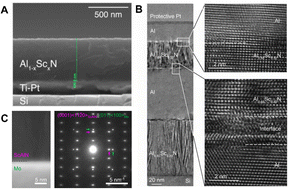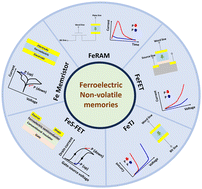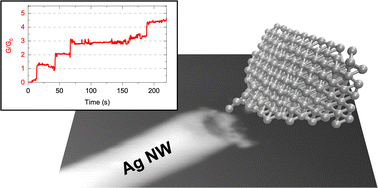Themed collection Memristors and Neuromorphic Systems

Introduction to memristors and neuromorphic systems
Xiaodong Chen, Cheol Seong Hwang, Yoeri van de Burgt and Francesca Santoro present a themed collection in Materials Horizons and Nanoscale Horizons gathering the latest developments in memristive materials, device fabrication, characterization and circuit design for neuromorphic systems.

Mater. Horiz., 2024, Advance Article
https://doi.org/10.1039/D4MH90052A
Oxovanadium electronics for in-memory, neuromorphic, and quantum computing applications
Redox- and spin-active macrocyclic vanadyl(IV) complexes and polyoxovanadates(V) have promising structural and physicochemical characteristics for innovative bottom-up hybrid electronics.

Mater. Horiz., 2024,11, 1838-1842
https://doi.org/10.1039/D3MH01926H
Emerging ferroelectric materials ScAlN: applications and prospects in memristors
The research found that after doping with rare earth elements, a large number of electrons and holes will be produced on the surface of AlN, which makes the material have the characteristics of spontaneous polarization.

Mater. Horiz., 2024,11, 2802-2819
https://doi.org/10.1039/D3MH01942J
Growth of emergent simple pseudo-binary ferroelectrics and their potential in neuromorphic computing devices
Ferroelectric memory devices such as ferroelectric memristors, ferroelectric tunnel junctions, and field-effect transistors are considered among the most promising candidates for neuromorphic computing devices.

Mater. Horiz., 2024,11, 2355-2371
https://doi.org/10.1039/D4MH00153B
Emerging memristive artificial neuron and synapse devices for the neuromorphic electronics era
A review and universal benchmark for assessing the artificial neuron and synapse device performance from an energy perspective, with the introduction of neuromorphics from biological to electronics and their prospects.

Nanoscale Horiz., 2023,8, 1456-1484
https://doi.org/10.1039/D3NH00180F
Memristive Monte Carlo DropConnect crossbar array enabled by device and algorithm co-design
A one-selector-one-memristor crossbar array was developed, capable of driving Monte Carlo DropConnect network. This could be achieved through a hardware and algorithm co-design approach, involving mutual improvement of them.

Mater. Horiz., 2024, Advance Article
https://doi.org/10.1039/D3MH02049E
Affective computing for human-machine interaction via bionic organic memristor exhibiting selective in-situ activation
Mater. Horiz., 2024, Accepted Manuscript
https://doi.org/10.1039/D3MH01950K
Origin of discrete resistive switching in chemically heterogeneous vanadium oxide crystals
Vacancy-induced filament formation and rupturing across Magnéli phases of VO2. The resistive switching shows the variations in threshold voltage with discreteness as a function of number of cycles.

Mater. Horiz., 2024, Advance Article
https://doi.org/10.1039/D4MH00034J
An organic brain-inspired platform with neurotransmitter closed-loop control, actuation and reinforcement learning
Organic neuromorphic platforms have recently received growing interest for the implementation and integration of hybrid systems, acting as a bridge between biological tissue and artificial computing architectures.

Mater. Horiz., 2024,11, 2865-2874
https://doi.org/10.1039/D3MH02202A
High-performance one-dimensional halide perovskite crossbar memristors and synapses for neuromorphic computing
Pyridinium-templated one-dimensional (1D) halide perovskites are studied as crossbar memristive materials for artificial neural networks with higher on–off ratios, enhanced endurance, and superior retention characteristics.

Mater. Horiz., 2024,11, 2643-2656
https://doi.org/10.1039/D3MH02055J
Oxygen tracer diffusion in amorphous hafnia films for resistive memory
We quantified the oxygen tracer diffusion in amorphous hafnium oxide thin films. These tracer diffusion values are consistent with the experimentally measured retention times of hafnium oxide resistive memory devices.

Mater. Horiz., 2024,11, 2372-2381
https://doi.org/10.1039/D3MH02113K
Memory effect and coexistence of negative and positive photoconductivity in black phosphorus field effect transistor for neuromorphic vision sensors
Black phosphorus (BP) field-effect transistors with ultrathin channels exhibit unipolar p-type electrical conduction over a wide range of temperatures and pressures.

Mater. Horiz., 2024,11, 2397-2405
https://doi.org/10.1039/D4MH00027G
Ovonic threshold switching-based artificial afferent neurons for thermal in-sensor computing
This research demonstrates an OTS-based temperature-sensing afferent neuron that features low power consumption and a compact circuit structure.

Mater. Horiz., 2024,11, 2106-2114
https://doi.org/10.1039/D4MH00053F
Experimental demonstration of combination-encoding content-addressable memory of 0.75 bits per switch utilizing Hf–Zr–O ferroelectric tunnel junctions
We have fabricated 4-CECAM (with keys encoded into 8-long binary arrays and 8 FTJs) with a content density of 0.75 bits per switch, which highlights 50% increase in content density compared to that of the conventional TCAM (0.5 bits per switch).

Mater. Horiz., 2024, Advance Article
https://doi.org/10.1039/D3MH02218H
Analytical modelling of the transport in analog filamentary conductive-metal-oxide/HfOx ReRAM devices
The recent co-optimization of memristive technologies and programming algorithms enabled neural networks training with in-memory computing systems.

Nanoscale Horiz., 2024,9, 775-784
https://doi.org/10.1039/D4NH00072B
Reliability effects of lateral filament confinement by nano-scaling the oxide in memristive devices
We fabricate a nano-device that laterally confines the switching oxide and filament to 10 nm. Electrical measurements demonstrate lower variability and reduced ionic noise compared to unconfined filaments, which is supported by our 3D simulation.

Nanoscale Horiz., 2024,9, 764-774
https://doi.org/10.1039/D3NH00520H
Physical reservoirs based on MoS2–HZO integrated ferroelectric field-effect transistors for reservoir computing systems
This work demonstrated a high-performance ferroelectric field-effect transistor (FeFET) via the integration of HZO and 2D MoS2, showing efficacy in processing diverse real-life tasks within a reservoir computing system.

Nanoscale Horiz., 2024,9, 752-763
https://doi.org/10.1039/D3NH00524K
Multicolor vision perception of flexible optoelectronic synapse with high sensitivity for skin sunburn warning
We propose a self-powered flexible optoelectronic synapse based on PEA2SnI4 films for multicolor vision perception and skin sunburn warning.

Mater. Horiz., 2024,11, 1934-1943
https://doi.org/10.1039/D3MH02154H
Fully printed memristors made with MoS2 and graphene water-based inks
Fully printed memristors based on silver and water-based 2D material inks were demonstrated on rigid and flexible substrates. The Ag filaments formation depends on the annealing process and can be inhibited by integrating CVD graphene in the device.

Mater. Horiz., 2024,11, 1344-1353
https://doi.org/10.1039/D3MH01224G
Insights into synaptic functionality and resistive switching in lead iodide flexible memristor devices
Neuromorphic platforms are gaining popularity due to their superior efficiency, low power consumption, and adaptable parallel signal processing capabilities, overcoming the limitations of traditional von Neumann architecture.

Nanoscale Horiz., 2024,9, 438-448
https://doi.org/10.1039/D3NH00505D
Electrochemical rewiring through quantum conductance effects in single metallic memristive nanowires
In this work, Milano et al. reported on quantum conductance effects in memristive nanowires, unveiling the origin of deviations of conductance levels from integer multiples of the conductance quantum and analyzing conductance fluctuations over time of memristive devices.

Nanoscale Horiz., 2024,9, 416-426
https://doi.org/10.1039/D3NH00476G
Heterogeneous reservoir computing in second-order Ta2O5/HfO2 memristors
The mixture of leaky and self-rectifying memristors in the reservoir increases the accuracy in MNIST-digits recognition task.

Nanoscale Horiz., 2024,9, 427-437
https://doi.org/10.1039/D3NH00493G
Stretchable and neuromorphic transistors for pain perception and sensitization emulation
A fully stretchable artificial pain perception nociceptor is prepared. The device is stretched in various ways with stable synaptic and nociceptor simulation performance. This work contributes to the development of flexible sensor devices.

Mater. Horiz., 2024,11, 958-968
https://doi.org/10.1039/D3MH01766D
3D simulation of conductive nanofilaments in multilayer h-BN memristors via a circuit breaker approach
A 3D simulation of conductive nanofilaments (CNFs) in multilayer hexagonal-BN memristors is performed.

Mater. Horiz., 2024,11, 949-957
https://doi.org/10.1039/D3MH01834B
An in-sensor humidity computing system for contactless human–computer interaction
Respiratory detection and contactless human–computer interaction capacity is achieved by a humidity-sensitive memristor.

Mater. Horiz., 2024,11, 939-948
https://doi.org/10.1039/D3MH01734F
Neuromorphic devices realised using self-forming hierarchical Al and Ag nanostructures: towards energy-efficient and wide ranging synaptic plasticity
Self-formed hierarchical structures of Al and Ag closely mimicking the biological neural network offer wide range synaptic plasticity with ultra-low energy usage. Al islands can be exploited as contact pads to introduce multiple sensory signals.

Mater. Horiz., 2024,11, 737-746
https://doi.org/10.1039/D3MH01367G
Adapted MLP-Mixer network based on crossbar arrays of fast and multilevel switching (Co–Fe–B)x(LiNbO3)100−x nanocomposite memristors
MLP-Mixer neuromorphic network based on nanocomposite memristive synapses has been developed for efficient and robust classification of images.

Nanoscale Horiz., 2024,9, 238-247
https://doi.org/10.1039/D3NH00421J
Multistate switching of scanning tunnelling microscopy machined polyoxovanadate–dysprosium–phthalocyanine nanopatterns on graphite
We demonstrate the formation of stable monolayers of polyoxometalates on a graphite substrate, which can be electronically multi-level switched and nanostructured without physical contact by the electric field of a scanning tunnelling microscope tip.

Nanoscale Horiz., 2024,9, 233-237
https://doi.org/10.1039/D3NH00345K
A high-dimensional in-sensor reservoir computing system with optoelectronic memristors for high-performance neuromorphic machine vision
A high-dimensional in-sensor reservoir computing system with optoelectronic memristors is demonstrated utilizing optical and electrical masks. Handwritten digit classification and human action recognition are successfully achieved with high accuracy.

Mater. Horiz., 2024,11, 499-509
https://doi.org/10.1039/D3MH01584J
About this collection
In late 2022, ChatGPT was launched with global impact across many different fields and society. However, similar to other artificial intelligence (AI) algorithms it has a substantional downside: consuming a lot of energy. ChatGPT requires almost ten times more energy cost than a conventional search algorithm, such as Google, as the large language model used in this new algorithm is built on a massive neural network, where the number of parameters to be optimized is overwhelming (several hundreds of billions). These models fundamentally belong to machine learning algorithms, where backpropagation-based deep learning produces remarkable performances. However, these methods are entirely disparate from human brain operation, which operates in a massively parallel and spike-based fashion and vastly outperforms computing algorithms in some classification tasks at much lower energy cost.
The research field dedicated to mimicking the brain is called neuromorphic engineering, and covers a wide range of disciplines, including electrical engineering, computing, materials science, chemistry, physics, and even psychology. Yet, conventional CMOS-based hardwares are based on the von-Neumann architecture which operates sequentially (instead of in parallel) suffling data back and forth between processing and memory, and thus barely fulfil the low-energy requirements for neuromorphic engineering. Memristors, which can be synaptic, neural, or even a combination of both, offer a potential solution and as such have been the focus of enhanced research efforts. In addition to their low-energy cost requirements, new materials properties employed by memristors may lead to new algorithms or help solve conventionally challenging tasks, such as NP-hard problems.
This themed collection in Materials Horizons and Nanoscale Horizons guest edited by Prof. Xiaodong Chen (Nanyang Technological University, Singapore), Prof. Cheol Seong Hwang (Seoul National University, Korea), Prof. Francesca Santoro (Forschungszentrum Jülich, Germany) and Prof. Yoeri Van de Burgt (Eindhoven University of Technology, The Netherlands) aims to report the latest developments in memristive materials. Exploring their fabrication, characterization, circuit design, and performance for applications in the future of neuromorphics.